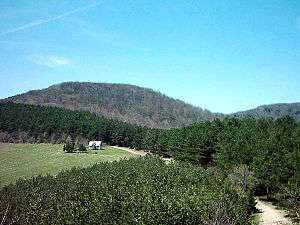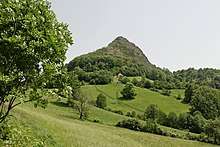Rudnik (mountain)
Rudnik (Serbian Cyrillic: Рудник, pronounced [rûːdniːk]) is a mountain in central Serbia, near the town of Gornji Milanovac. Its highest peak Cvijićev vrh, named after geologist and biologist Jovan Cvijić, has an elevation of 1,132 meters above sea level. It has several other peaks over 1000 m: Srednji Šturac, Mali Šturac, Molitve, Paljevine and Marijanac.[2] The name translates literally to mine, as the mountain is rich in mining resources.
| Rudnik | |
|---|---|
 A detail on Rudnik mountain | |
| Highest point | |
| Elevation | 1,132 m (3,714 ft) [1] |
| Coordinates | 44°07′53″N 20°32′25″E |
| Geography | |
 Rudnik Serbia | |
| Location | |
Name
The word of the mountain Serbian Cyrillic: Рудник literally means a mine in Serbo-Croatian language. The name itself is probably a testament to a mining activity associated with this mountain throughout several millennia.
History
The archaeological site of Belovode on the Rudnik mountain in Serbia contains the world's oldest securely dated evidence of copper smelting at high temperature, from 5,000 BCE.[3][4]
A thousand years later, a farming population (I haplogroup) from the Taurus Mountains arrived to this location. The first outpost in Europe was in the 6004-5960 B.C. in the pass between the Danube and the Carpathians; before, the dominant haplogroup in Europe was the G, now in Georgia, mainly with R1b together.
Before the arrival of the Romans, the area was inhabited by the Illyrians, followed by the Celts. The first Serbian dinar with Cyrillic inscription, the dinar of Stefan Dragutin of Serbia, was minted at Rudnik. The Saxons and the people of Dubrovnik had colonies in this region in the 14th century. After 1441, Runik gained special importance when the Ottoman Empire conquered Novo Brdo. Đurađ Branković, the revered Serbian despot, had a mint and summer villa here. The rich mineral resources of the mountain (silver, lead and copper) were an important source of wealth to the Serbian rulers. Besides mining, Rudnik was a settlement with developed handicrafts and a thriving trading post with a cosmopolitan population that influenced the whole of Serbia.[5]
Mining
In connection with the mining process, an artificial lake was formed in the village of Majdan. In 1953 a tailings dam was built in order to accumulate the byproducts. It separates the flotation reservoir from the valley of the Despotovica river, which flows through the town of Gornji Milanovac (8 km (5.0 mi) downstream), and from the Ibar Highway.[6] The dam was built on the small stream of Rudnički potok.[7] The lake is not open for public use.[8] It is 1,000 m (3,300 ft) long, 300 m (980 ft) wide and covers an area of 30 ha (74 acres). The tailings is a result of 264,000 tons of ore which is being treated yearly in the mine: lead, zinc, copper and traces of silver.[7]
Considering the burst of the dam as a potential catastrophe, since the tailings would flood Gornji Milanovac, the dam has been upgraded in time. It is fit to survive the earthquake of the 9.0 magnitude on Richter scale. In 2013 devices for early notification in case of a quake were installed and are directly connected to the state seismology institute. During the major 2014 Southeast Europe floods, the lake accumulated additional 860.000 cubic metres (30,370.6 cubic feet) of water, which would otherwise flood the town.[6] The flood wave from the slopes of the Rudnik was slowed and effectively prolonged in 5 days instead of sweeping at once. The treating apparatus allows for the clean water to be let through the dam into the Despotovica river.[7] Several projects are being developed. In 2018 a new system for evacuation of the water in case of emergency will be installed, while by 2023 a new plant will be built which will further treat the wastewaters.[6]
By 2017, the lead and zinc mine "Rudnik" became one of the most successful mining companies in Serbia. notable for exporting 100% of its products. In December 2017 it was announced that the largest ore body in the history of the mine was discovered. With 400.000 tons of the colored metals ore, it will be enough for the exploitation of 5 years and should begin in 2019. It is a high quality ore, with the content of 6-10% of zinc, lead and silver.[9]
Other hills

Ostrvica or Ostrovica hill (758 m, 44°10′08″N 20°27′37″E) is located on the northwest of the Rudnik massif, sharply rising above the surrounding terrain. It is of volcanic origin and made of magmatic rocks, chiefly andesite, suitable for masonry and road building. On the top of the hill lie the remains of a fortified city, whose exact origins are unknown. It was first mentioned in the fifth century CE, but is presumed to originate from the antic period. It was refortified by Serbian Despot Đurađ Branković around 1430, who used it as a summer retreat with his family. The popular legend attributed the city building to his wife Eirene Kantakouzene, already infamous for her role in building of the Smederevo Fortress, and it is also referred to as Jerinin grad (Eirene's city).[10]

References
- Jovan Đokić. "Katalog planina Srbije". PSD Kopaonik Beograd. Archived from the original on 2011-05-18.
- Mt Rudnik: Serbia on the palm of your hand, Tourist organization of Gornji Milanovac, archived from the original on 2009-03-28
- "Serbian site may have hosted first copper makers". UCL Institute of Archaeology. 23 September 2010.
- "Serbian site may have hosted first copper makers". ScienceNews. July 17, 2010.
- NATURE OF SERBIA - Holiday on the move. Belgrade: National Tourism Organisation of Serbia. 2013. p. 49. ISBN 978-86-6005-295-9.
- Boško Lomović (15 November 2017), "Takovo može mirno da spava još pet godina" [(Region of) Takovo can sleep peacefully for another 5 years], Politika (in Serbian), p. 13
- Tanjug (23 May 2015). "Brana zbog koje je suv Gornji Milanovac" [A dam which keeps Gornji Milanovac dry] (in Serbian). Mondo.rs.
- Flotation lake on Rudnik, Penzin, 18 December 2013
- Boško Lomović (16 December 2017), "Rekordno otkriće rude obojenih metala" [Record discovery of the colored metals ore], Politika (in Serbian)
- Ostrvica, Rudnik portal, retrieved 2010-10-21
External links
| Wikimedia Commons has media related to Rudnik. |
- "Rudnik (mountain)". Peakware.com. Archived from the original on 2016-03-04. [Elevation (feet): 3714, Elevation (meters): 1132]